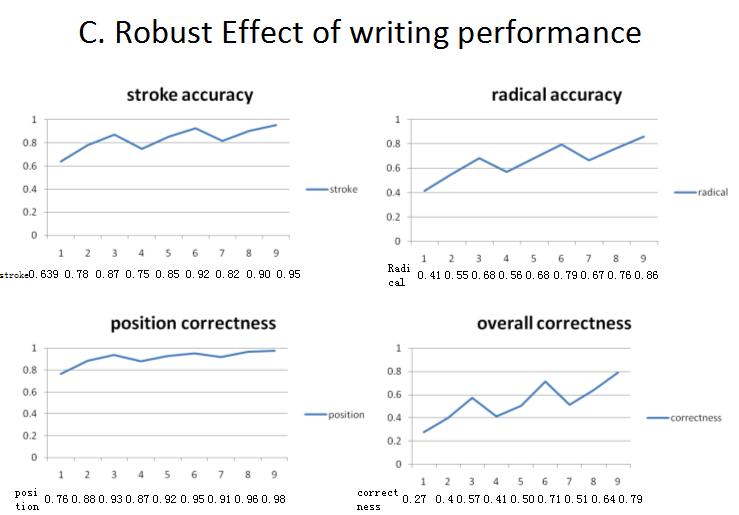Perfetti - Read Write Integration
Read Write Integration
Contents
[hide]Summary Table
- Node Title: Integrating writing with reading
- Researchers: Qun (Connie) Guan, Fan Cao, Derek Chan, Charles Perfetti, Suemei Wu
- Study Start Date Sep 1, 2009
- Study End Date August 31, 2010
- LearnLab Site and Courses , CMU Chinese (Classroom and Online)
- Number of Students: 30
- Number of Stimuli: 120 characters (30X2 experimental, 30X2 control)
- Planned Participant Hours for the study: 200
- Data in the Data Shop: Phase-I experiments have completed in fall 2009, Phase-II experiments will start in Spring 2010
Abstract
Writing may have a specific effect, one word at a time. If so, individual characters must be practiced more than the 1-3 times as we have done in the previous projects. We will test a range of practice values within subjects in the fall to derive learning functions for given numbers of practice units. The general goal of this project is to establish a causal explanation of why writing characters helps reading the characters. Two-phased studies will be conducted, one behaviroal study, and one brain-imaging study, to test the hypothesis that a perceptual motor trace (reflected in frontal recognition areas of the brain) are candidate for becoming part of a word recognition network with writing practice.
Background & Significance
To reach a high level of Chinese proficiency, a learner needs to build robust bidirectional connections between the linguistic constituents. However, the connections are not acquired at the same rate of learning (Liu, Wang, & Perfetti, 2007). We found that the orthographic form knowledge came early, during the first term of a course, but that character meaning and especially pronunciation took longer to acquire. the writing-with-reading procedure is a possible answer to increasing the learner's integration of knowledge components. This idea follow from the close relationship between writing and learning to read in Chinese L1 learners (Tan, Spinks, Eden, Perfetti, & Siok, 2005).
In an initial in-vivo study in whcih students wrote briefly viewed characters while learning to read them, we found evidence for facilitation of writing on some measures of character learning (such as meaning acquistion and the character form recognition, but not phonological measures). In the Spring of 2009, we carried out a second major study, in which pinyin-typing and handwriting both were used as procedures that would build character knowledge. The hypothesis was that writing would behefit character-to-meanign learning while pinyin typing would benefit character-to-pronunciation learning. Generally speaking, we found across 2-day writing training, there was a writing effect on some orthographic-based task performance; and pinyin-typing facilitated character-to-sound learning only after Day-1 training.
Research Questions
Does learning to write while learning to read support learning to read? If so, is the effect only on form recognition or does meaning and pronunciation access also benefit? If this learning is character by character (word by word), how much writing practice is needed for robust learning effects. Do writing-on-reading effects reflect the establishment of neural-motor representation that becomes part of a word recognition network?
Independent Variables
- Handwriting vs. Pinying-writing [See the Interface in a related study: http://www.learnlab.org/research/wiki/index.php/Integration_of_reading%2C_writing_and_typing_in_learning_Chinese_words]
- Practice Values (i.e., the number of practice trials per day, day 1 to day 3)
Dependent Variables
- Constituent learning (character form, pinyin, tone, and the English meaning)
- Visual recognition (lexical decision, partial character recognition )
- Sound recognigion (character sound matching task)
- Meaning recognition (character meaning matching task)
Hypotheses
Phase I Hypothesis
Writing characters helps reading the characters.
Phase II Hypothesis
A perceptual motor trace that interacts with visual recognition components would strengthen the representation of the character.
Results
Phase I Results
Practice Effect
We found the practice effect on the following seven dependent measures.
- 1) the accuracy rate for making decision on whether a character is a real one or not (i.e., lexical decision task)
- 2) the reponse time for making decision on whether two characters are the same (i.e., partical character recognition task)
- 3) the accuracy rate for making decision on whether two characters are the same (i.e., partial character recognition task)
- 4) the accuracy rate for judging whether a character and an English meaning match (i.e., meaning matching task)
- 5) the response time for judging whether a character and an English meaning match (i.e., meaning matching task)
- 6) the accuarcy rate for judging whether a character and a sound match (i.e., sound matching task)
- 7) the response time for judging whether a character and a sound match (i.e., sound matching task).
Writing Effect
We found the writing effect on the following four dependent measures.
- 1) the accuracy rate for making decision on whether a character is a real one or not (i.e., lexical decision task)
- 2) the reponse time for making decision on whether two characters are the same (i.e., partical character recognition task)
- 3) the accuracy rate for judging whether a character and an English meaning match (i.e., meaning matching task)
- 4) the response time for judging whether a character and an English meaning match (i.e., meaning matching task)
Robust Effect
Robust Effect of Writing Performance by Practice

Phase II Results
Explanation
- A skilled speaker-reader of Chinese develops a word representation that includes strong interconnections among the word’s graphic, phonological, and semantic constituents (Perfetti, Liu, and Tan, 2005).
- The distinctive spatial qualities of Chinese in combination with its non-alphabetic mapping make writing an especially important support for the acquisition of a character recognition system.
- Orthographic awareness and motor programming that mediate writing plays a central role in Chinese reading acquisition.
- Our prior work in neuroimaging of Chinese (e.g., Siok, Perfetti, Jin, & Tan, 2004) has identified frontal recognition areas (specific to Chinese) that are close to motor cortex and thus are candiates for becoming part of a word recognition network with writing practice.